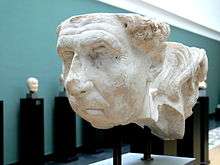Annales (Ennius)

Annales is the name for the highly fragmentary Latin epic poem written by the Roman poet Ennius in the 2nd century BC.
Contents
The poem was originally published in fifteen books, although Ennius later amended it with three others.[1] Fragments of the Annales, as well as ancient testamonia, suggest that Ennius opened his epic with a recollection of a dream. In this reverie, the poet claims that Homer appeared to him and informed him that, thanks to the transmigration of souls, his spirit had been reborn into Ennius.[2]
The poem’s contents seems to have been organized into triads with a "concentric, symmetrical structure". The first seven books concerned the events before the author's existence, whereas the following eight (and eventually, eleven) dealt with events during Ennius’ life.[3] Although most of the poem has been lost, there is a "traditional" (albeit conjectured) organization for the book.[4] The poem's first three books cover the fall of Troy in 1184 BC to the reign of Lucius Tarquinius Superbus c. 535–509 BC.[1][5] Books 4–6 revolve around the early Republic up until the Pyrrhic War in 281–271 BC. Books 7–9 deal with the First (264–241 BC) and Second (218–201 BC) Punic Wars, as well as the events occurring during this swath of time in the East. Books 10–12 focus on the Second Macedonian War until possibly the beginning of Rome’s campaign against Antiochus III the Great, c. 192 BC. The following three books detail the war against Antiochus (192–188 BC) until the events of the Aetolian War (191–189 BC).[5] The final three books (added to the poem after its publication) concern portions of the Istrian and Macedonian Wars (214–148 BC).[1][5]
Style
Whereas Ennius’s contemporaries like Livius Andronicus and Naevius wrote in Saturnian verse, Ennius broke from Latin tradition and composed the Annales in dactylic hexameter, in imitation of the works of Homer. This soon became the standard metre for Latin epic poems.[1]
Many scholars have declared that Ennius' poem functions as "a mediator between Homer and Vergil"; in other words, it is claimed that the Annales transmits the style of Homer into a decidedly Latin tradition, which would eventually be used by Virgil when it came time for him to pen his epic poem, the Aeneid. A large reason for this is because around 80 percent of what is preserved of Ennius comes from commentators, who were quoting Ennius's work so as to contrast it to Virgil's Aeneid.[6] Jackie Elliott, however, points out that the extant fragments not derived from the quotations of commentators do not display the same "epic" style of either Homer or Virgil. Thus, she argues that "to the extent that the Annales today seem to the modern reader crucial to the epic tradition, they are the creation of Vergil and of the Vergiliocentric sources."[7] Put another way, the understanding of the Annales as decidedly "epic" is a largely post facto one, engendered by its entextualization in commentaries on the Aeneid (i.e. the aforementioned "Vergiliocentric" sources).[7]
Remains
Over time, almost all of the work has been lost, and today only around 620 lines or partial lines remain, largely preserved in quotations by other authors.[8] Fragments of the poem were also found in the library at Herculaneum.[9]
The first collection of the Annales fragments was published in the later part of the 16th century. In the 19th century, the German philologist Johannes Vahlen was a key figure in the study of Ennius' Annales. Goldschmidt, however, argues that the British classicist Otto Skutsch's book The Annales of Ennius (1985) is the "standard" for anyone interested in examining the fragments of the poem. A later edition supervised by Enrico Flores sought to reconsider "both the textual scholarship of the sources and the contextual placement of the fragments."[8]
References
Footnotes
- 1 2 3 4 Keith 2013, p. xiv.
- ↑ Aicher, Peter (Summer 1989). "Ennius' Dream of Homer". The American Journal of Philology. 110 (2): 227–232. JSTOR 295173.
- ↑ Boyle 2003, pp. 37–38.
- ↑ Elliott 2013 p. 298.
- 1 2 3 Boyle 2003, p. 38.
- ↑ Elliott 2013, pp. 75–134.
- 1 2 Elliott 2013, p. 134.
- 1 2 Goldschmidt 2013, p. 1.
- ↑ Kleve, Knut (1991). "Phoenix from the Ashes: Lucretius and Ennius at Herculaneum" (PDF). The Norwegian Institute at Athens. Retrieved July 14, 2016.
Bibliography
- Boyle, Anthony, ed. (2003). Roman Epic. Routledge. ISBN 9781134763252.
- Elliott, Jackie (2013). Ennius and the Architecture Of the Annales. Cambridge University Press. ISBN 9781107027480.
- Goldschmidt, Nora (2013). Ennius' Annales and Virgil's Aeneid. Oxford University Press. ISBN 9780199681297.
- Keith, Alison (2013). A Latin Epic Reader: Selections from Ten Epics. Bolchazy-Carducci. ISBN 9781610411103.